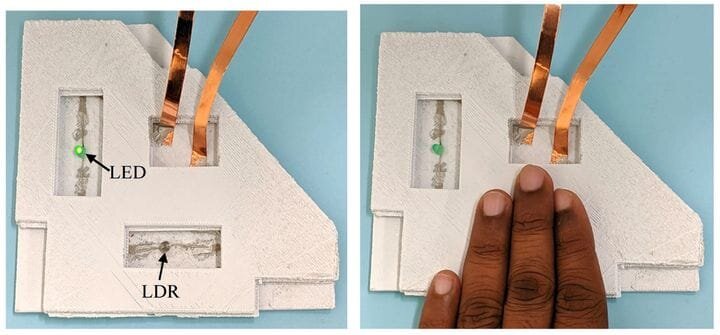![Testing a 3D printed circuit: it works! [Source: ScienceDirect]](https://fabbaloo.com/wp-content/uploads/2020/05/image-asset_img_5eb08d4d299e2.jpg)
Researchers at Rutgers University have developed an unusual method of 3D printing electrically conductive circuits.
3D printing electronics has long been a goal of researchers, as that capability could theoretically enable the printing of fully functional objects that use electronics.
However, this has proven challenging for a variety of reasons.
3D Printing Circuits
3D printing now encompasses many different processes, but they all seem to have the same limitation: only one material can be used; or more specifically, only one type of material environment may be used. It’s difficult to 3D print materials with vastly different glass transition temperatures at the same time, for example.
Nevertheless, several approaches have been designed to overcome such limitations. Want to 3D print metal in a filament device? Easy: 3D print metal powder mixed with a “normal” 3D printable material and then sinter the resulting 3D print afterwards. The result is close to, but not exactly pure metal.
What about 3D printing electronics? Several approaches have been proposed, mostly involving some type of conductive filament that is quietly extruded along with normal structural 3D printable material. However, these conductive materials are usually compromised in some manner, usually having lesser electrical properties than one might expect to use for functional devices.
Intense Pulsed Light
Now the researchers have developed an unusual approach. They explain:
“We explore the mechanisms underlying the combination of Fused Filament Fabrication (FFF) of ABS and PLA polymer structures, printing of silver NPs (mixed nanowires and nanospheres), and out-of-chamber Intense Pulsed Light (IPL) sintering of the printed circuits. IPL of only-nanosphere based circuits on the FFF-made structure thermally damages the polymer without any resistivity reduction. In a significant advance, the addition of nanowires achieves a resistivity several times lesser than the state-of-the-art (13.1 μΩ-cm or 8 x bulk silver) without any thermal damage and within 0.75 s of IPL.”
![A process for 3D printing electrical circuits [Source: ScienceDirect]](https://fabbaloo.com/wp-content/uploads/2020/05/image-asset_img_5eb08d4d83174.jpg)
Conductive 3D Print Material
In other words, they’ve devised a material mix that can be solidified with an intense, but brief light pulse that does not diffuse excess heat into surrounding areas.
This suggests they should be able to 3D print usable circuit material throughout a 3D print without compromising either electrical properties or the structure holding the circuit. That’s a bit of a change from current capabilities.
It also allows the use of common 3D printing materials such as ABS and PLA for use with embedded circuitry, rather than more expensive higher-temperature materials that require dedicated equipment to produce.
This sounds straightforward, but the secret seems to be in the chemistry of the material. The addition of the tiny nanowires has changed how the material reacts to the IPL, as observed by electron microscope. The researchers have performed extensive testing on the resulting prints and have verified the substantial gains in electrical properties.
Electrical 3D Printing
In spite of several attempts, we have yet to see a practical method of 3D printing circuits appear on the market that industry accepts. Perhaps this new technology may be commercialized in the future, and that could change everything.
Via ScienceDirect

